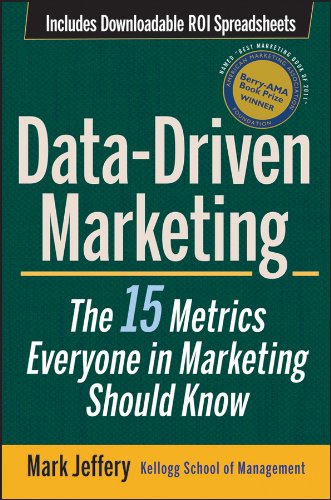Mark Jeffery‘s book “Data-driven marketing: the 15 metrics everyone in marketing should know” is a guide to data marketing. The book consists of 3 parts, which include 11 chapters.
The book describes in detail the main marketing metrics and cases of successful and failed marketing campaigns, gives tips on how to avoid common mistakes and develop a marketing strategy, templates of analytical tables, descriptions of methods and measurement tools.
Mark Jeffery believes that the key to a company’s success is using data-driven marketing. The author advises not to try to use all marketing metrics in your work since there are a large number of them.
Measurements help improve marketing results because they clearly show what works and what doesn’t. In his book, he identifies 15 main marketing metrics: 10 of them are classical, and five are related to Internet Marketing.
The metrics 1-5 are essential nonfinancial metrics
- Brand Awareness – is a key metric of brand performance in the market. Brand awareness is responsible for the ability of customers to recall or recognize a brand in various situations. A brand increases the value of a product, service, or company.
- Test-Drive. A test drive involves testing a product by a consumer before selling it. If a customer has tried a product or service, they are more likely to purchase it.
- Churn Rate shows the percentage of consumers who stop buying a product over a certain period of time. Reducing customer churn can significantly increase the company’s profit.
- Customer Satisfaction (CSAT). Mark Jeffrey calls this metric the golden marketing metric that connects branding and consumer loyalty. A customer who has a high level of satisfaction from interacting with the company will in most cases return again, make a purchase again, and recommend the company to their environment.
- Take Rate allows you to measure the internal effectiveness of a marketing campaign and is defined as the percentage of customers who accept your offer. Increasing the take rate and reducing revenue for attracting customers can significantly reduce the marketing budget.

The metrics 6-10 are essential financial metrics
- Profit. Any company strives to get the maximum profit from its activities.
- Net Present Value (NPV). This profitability indicator is used when making decisions about investing in a marketing campaign — if the NPV is less than 0, then it is not worth investing.
- Internal Rate of Return (IRR). IRR-discount rate for funds invested in the campaign, with NPV = 0. Shows the profitability of the project in a certain period of time (5, 7, 10 years).
- Payback. This metric helps you determine the time that we will fully reimburse you for your expenses.
- Customers Lifetime Value (CLTV). This metric shows the return on investment in the client. It demonstrates how profitable the cooperation is and whether it is worth changing the marketing policy.
The last five metrics are Internet marketing indicators, which demonstrate the effectiveness of the website, social media marketing, and search engine promotion.
The metrics 11-15 are essential internet marketing metrics
- Cost per Click (CPC) is an advertising model used on the Internet, according to which an advertiser pays search engines and an Internet resource for one-click on their ad.
- Transaction Conversion Rate (TCR). This is the percentage of consumers who purchased after clicking on an ad.
- Return on Ad Dollars Spent (ROA) is a coefficient that evaluates the effectiveness of creating profits from all areas of marketing investment.
- Bounce Rate. This metric indicates the quality of leads. When you can determine exactly where the bounces are coming from, you can reconfigure your targeting or opt-out of a particular ad platform altogether. A lead is a person who came through an ad or link and may want to buy your product. Targeting is a marketing mechanism that allows you to identify people who are interested in your ads. You can target people by geographical, age, professional, and other characteristics.
- Word of Mouth (WOM) is informal forms and methods of transmitting oral or written information about a product or service from consumer to consumer, as well as those companies that want their information to reach the consumer through rumors.

Mark Jeffery advises to consider indicators 11, 12, and 13 comprehensively and optimize them as much as possible.
Mark Jeffery describes an effective marketing campaign model. In his opinion, an effective marketing campaign is a closed cycle that includes four parameters of marketing management.
1. The choice of campaigns, investing in a campaign – choice.
2. Campaign management – plan.
3. Value – measuring indicators.
4. Feedback – adaptive learning.
The author identifies five areas of marketing campaigns
– Sales promotion. This type of marketing activity is aimed at increasing revenue immediately after the marketing campaign.
Examples: sales, coupons, and special offers.
– Branding and awareness. These areas help to increase the recognition and prestige of the brand.
Examples: sponsorship of sporting events, cultural events, brand advertising
– Improve customer relations. Working in this direction helps to increase customer loyalty and engagement.
Examples: thank-you letters after purchase, loyalty cards, birthday gifts.
– Creating a market niche. Marketers analyze opportunities for entering a new product or service, develop a plan for entering the market.
Examples: publications in blogs of opinion leaders, communication with analysts of companies operating in the B2B market.
– Infrastructure improvement. Investments are spent on technology development and training.
Examples: purchasing programs for managing marketing resources, training employees to work in these programs.
During the research, Mark Jeffery identified five main obstacles to applying data-driven marketing.
Five main obstacles to applying data-driven marketing
– Getting started. Managers do not know where to start due to a large number of marketing metrics.
– Causality. It is not possible to establish a causal relationship: the marketing campaign and consumer actions are separated over time; awareness campaigns do not always directly affect sales, but management requires information about the return on investment.
– Lack of data. There are no direct sales in the B2B market, it is not always clear who the end-user is; it is difficult to collect information due to the law on personal data protection.
– Resources and tools. There is no time, or it is expensive; no suitable tools for implementing data-based marketing; there is no working contact between marketers and IT departments.
– People and change. The marketers don’t measure because they don’t want to be controlled; the motivation system is not related to the results of marketing campaigns; people don’t have the skills to apply data-based marketing; marketers believe that accurate measurements kill creativity.
To overcome these obstacles, the author advises doing the following
- Focus on collecting the right data. Overcome the information chaos. Throw away all unnecessary.
- Obstacles related to causality can be overcome by implementing the necessary marketing metrics and conducting a number of experiments.
- Develop a strategy for obtaining customer data. B2B companies should develop a value proposition for partners and end-users, in exchange for which they should request the necessary data.
- Built the infrastructure for data-driven marketing. Create an infrastructure that allows you to scale your marketing strategy.
- Create a data-driven marketing culture. Train employees to work with marketing tools and metrics and link motivation to the main marketing metrics.
Mark Jeffery provides an approximate plan for implementing data-based marketing.
Plan to implement data-based marketing
1. Evaluate the current situation.
2. Diagnose the problem.
3. Conduct an experiment and get a quick result.
4. Select the appropriate tools.
5. Conduct measurements and optimize your strategy.

When implementing data-based marketing, keep in mind that regular measurements and data analysis are only useful if the marketing campaign has certain agility — the ability to make changes to the campaign when unsatisfactory measurement results are obtained.
Sometimes it is better to abandon planned actions than to redo something in the process and even stop the entire campaign if it does not produce the desired results.
Mark Jeffery also describes three main approaches to analytic marketing in his book: propensity modeling, marketing basket analysis, decision tree; event-driven marketing, and data-driven marketing infrastructure.
Many managers have difficulty understanding how marketing affects profits. They only see the costs that are spent on marketing events, and the result for them is still unclear, so in many cases, it is marketing budgets that are cut first.
Mark Jeffery in his book tried to combine the concepts of marketing and results into a single whole. In the book, he teaches marketers to speak the language of financial analytics, study numbers, and make forecasts.
The author explains how to work with data and talks about key metrics that will be useful for building a marketing strategy, as well as for convincing management of the need for a specific budget and reporting on the effectiveness of a marketing campaign.
Find more interesting marketing and sales book reviews in the Book Reviews section of my website.





